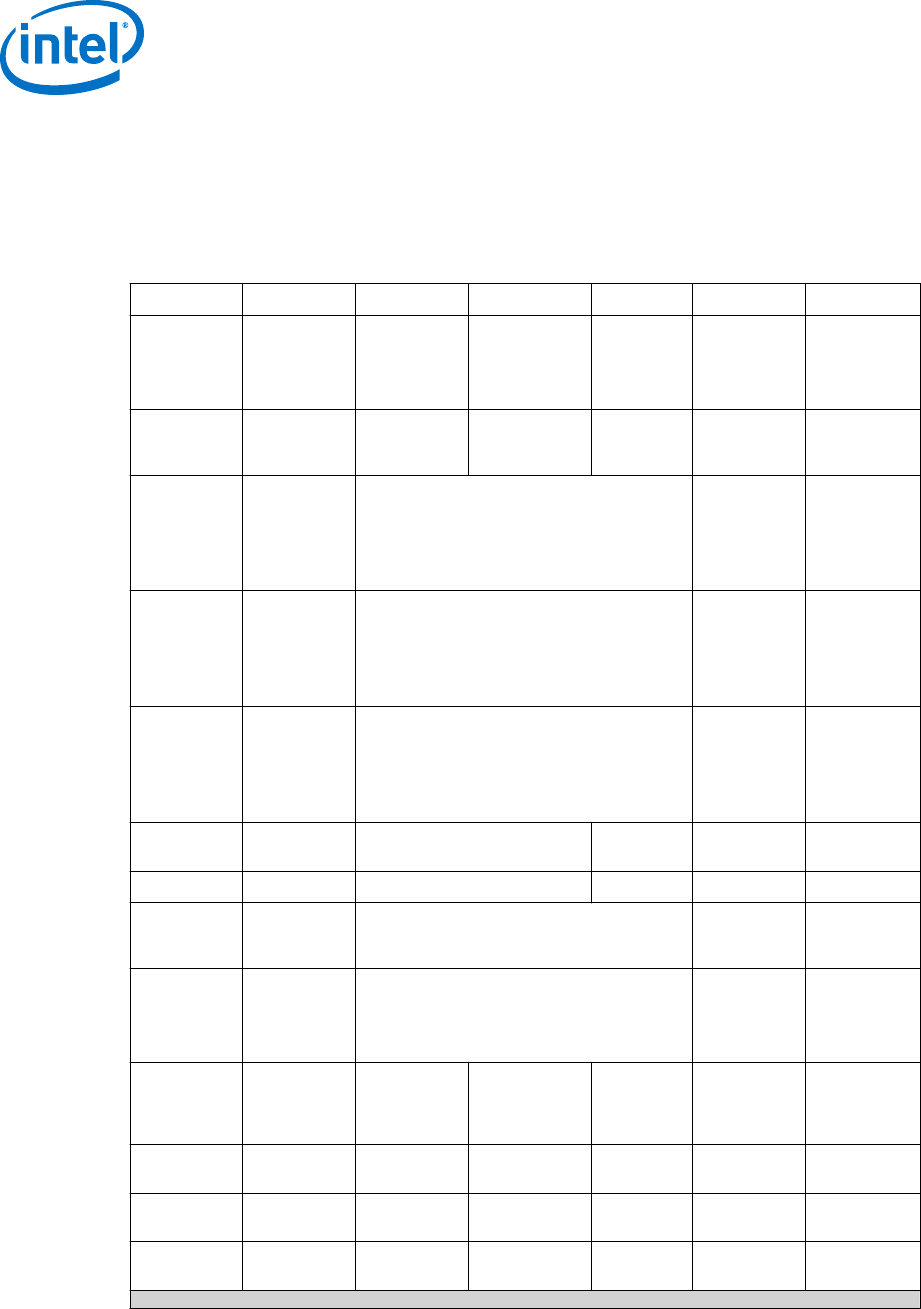Desktop 4th Generation Specification Sheet
Table Of Contents
- Contents
- Revision History
- 1.0 Introduction
- 2.0 Interfaces
- 3.0 Technologies
- 3.1 Intel® Virtualization Technology (Intel® VT)
- 3.2 Intel® Trusted Execution Technology (Intel® TXT)
- 3.3 Intel® Hyper-Threading Technology (Intel® HT Technology)
- 3.4 Intel® Turbo Boost Technology 2.0
- 3.5 Intel® Advanced Vector Extensions 2.0 (Intel® AVX2)
- 3.6 Intel® Advanced Encryption Standard New Instructions (Intel® AES-NI)
- 3.7 Intel® Transactional Synchronization Extensions - New Instructions (Intel® TSX-NI)
- 3.8 Intel® 64 Architecture x2APIC
- 3.9 Power Aware Interrupt Routing (PAIR)
- 3.10 Execute Disable Bit
- 3.11 Supervisor Mode Execution Protection (SMEP)
- 4.0 Power Management
- 4.1 Advanced Configuration and Power Interface (ACPI) States Supported
- 4.2 Processor Core Power Management
- 4.3 Integrated Memory Controller (IMC) Power Management
- 4.4 PCI Express* Power Management
- 4.5 Direct Media Interface (DMI) Power Management
- 4.6 Graphics Power Management
- 5.0 Thermal Management
- 5.1 Desktop Processor Thermal Profiles
- 5.2 Thermal Metrology
- 5.3 Fan Speed Control Scheme with Digital Thermal Sensor (DTS) 1.1
- 5.4 Fan Speed Control Scheme with Digital Thermal Sensor (DTS) 2.0
- 5.5 Processor Temperature
- 5.6 Adaptive Thermal Monitor
- 5.7 THERMTRIP# Signal
- 5.8 Digital Thermal Sensor
- 5.9 Intel® Turbo Boost Technology Thermal Considerations
- 6.0 Signal Description
- 6.1 System Memory Interface Signals
- 6.2 Memory Reference and Compensation Signals
- 6.3 Reset and Miscellaneous Signals
- 6.4 PCI Express*-Based Interface Signals
- 6.5 Display Interface Signals
- 6.6 Direct Media Interface (DMI)
- 6.7 Phase Locked Loop (PLL) Signals
- 6.8 Testability Signals
- 6.9 Error and Thermal Protection Signals
- 6.10 Power Sequencing Signals
- 6.11 Processor Power Signals
- 6.12 Sense Signals
- 6.13 Ground and Non-Critical to Function (NCTF) Signals
- 6.14 Processor Internal Pull-Up / Pull-Down Terminations
- 7.0 Electrical Specifications
- 8.0 Package Mechanical Specifications
- 9.0 Processor Ball and Signal Information

• AC tolerances for all DC rails include dynamic load currents at switching
frequencies up to 1 MHz.
Voltage and Current Specifications
Table 47. Processor Core Active and Idle Mode DC Voltage and Current Specifications
Symbol Parameter Min Typ Max Unit Note
1
Operational
VID
VID Range 1.65
2013D: 1.75
2013C: 1.75
2013B: 1.75
2013A: 1.75
1.86 V 2
Idle VID
(package
C6/C7)
VID Range 1.5 1.6 1.65 V 2
R_DC_LL
Loadline
slope within
the VR
regulation
loop
capability
2013D PCG: -1.5
2013C PCG: -1.5
2013B PCG: -1.5
2013A PCG: -1.5
mΩ 3, 5, 6, 8
R_AC_LL
Loadline
slope in
response to
dynamic load
increase
events
2013D PCG: -2.4
2013C PCG: -2.4
2013B PCG: -2.4
2013A PCG: -2.4
mΩ —
R_AC_LL_OS
Loadline
slope in
response to
dynamic load
release
events
2013D PCG: -3.0
2013C PCG: -3.0
2013B PCG: -3.0
2013A PCG: -3.0
mΩ —
T_OVS
Overshoot
time
500 uS
V_OVS Overshoot 50 mV
V
CC
TOB
V
CC
Tolerance
Band
± 20 (PS0, PS1, PS2, PS3) mV 3, 5, 6, 7, 8
V
CC
Ripple
Ripple ± 10 (PS0)
± 15 (PS1)
+50/-15 (PS2)
+60/-15 (PS3)
mV 3, 5, 6, 7, 8
V
CC,BOOT
Default V
CC
voltage for
initial power
up
— 1.70 — V —
I
CC
2013D PCG
I
CC
— — 95 A 4, 8
I
CC
2013C PCG
I
CC
— — 75 A 4, 8
I
CC
2013B PCG
I
CC
— — 58 A 4, 8
continued...
7.8
Processor—Electrical Specifications
Desktop 4th Generation Intel
®
Core
™
Processor Family, Desktop Intel
®
Pentium
®
Processor Family, and Desktop Intel
®
Celeron
®
Processor Family
Datasheet – Volume 1 of 2 December 2013
98 Order No.: 328897-004










